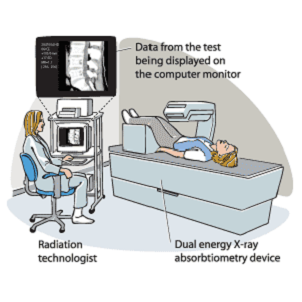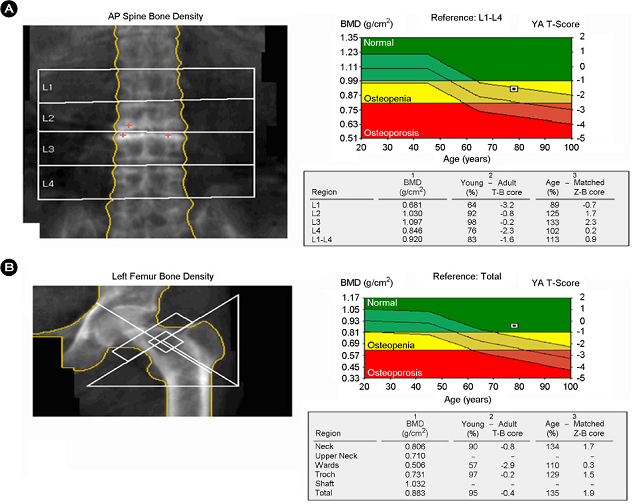What is Bone Mineral Densitometry (BMD)?
- BMD is one of the tests that uses low dose radiation to measure the amount of calcium and other minerals in the bones.
- This test also helps you detect osteoporosis and predict your risk of bone fractures.

Figure 1 : BMD examination being carried out
Source : http://benvieworld.blogspot.com/2010/07/bone-mineral-density-test.html
How and where can I get this examination?
- When you visit the treating physician, he/she will determine whether you require the examination.
- If necessary, the doctor will make a request for the examination using the radiology request form.
- This examination is available in certain government hospitals.
When is the BMD examination performed?
- The BMD ezamination is performed for the following reasons:
- To identify bone loss and osteoporosis
- To determine the effectiveness of osteoporosis medications
- To predict the risk of bone fractures
- You are encouraged to undergo a BMD examination should you have a tendency to get osteoporosis, ie if you are
- A woman aged 65 years and older
- A man aged 70 years and older.
- A women who is below 65 years and man who is between 50 to 70 yeras old are at risk of developing osteoporosis if he or she experiences the following:
- Fractured bone due to regular activity (brittle bone).
- Chronic Rheumathoid Arthritis, chronic kidney disease and food disorder that causes low body weight.
- Early menopause (either due to natural causes or due to exposure).
- History of hormonal treatment for prostate cancer or breast cancer.
- Drastic loss of height (signs of compression fracture in the spine).
- Smoker
- Family history of osteoporosis.
- Consumption of corticosteroid medications such as (Prednisolone, methylprednisolone) on a daily basis for a period of three months.
- Taking thyroid hormone replacement.
- Excessive alchohol consumption (more than 3 glasses a day).
- You are adviced to have a BMD examination on annual basis. However recent studies have shown some women can benefit by having a a longer interval between each screening test. Therefore you are adviced to seek medical advice to discuss with your medical practioner what is the best option for you.
Before the BMD procedure
- Stop medications that contain calcium and multivitamin that are in the form of pils a day before the examination.
- The radiographer will explain the procedure to you prior to the procedure.
- Please inform the radiographer if you are prgnant or suspect that you may be pregnant.
- You are adviced to wear the hopsital gown that is provided.
- Your weight and height is measured before you lie down on the examination couch.
- For women who have menopaused, you should inform the radiographer when you attained menopause.
During the BMD procedure
- You will be required to lie down on the BMD examination couch.
- The radiographer will position you to ensure that you body is aligned and straight and in the right position.
- The scanner and the table will move as the examination is in progress.
- The examination is carried out on the following area which are the hip area, backbone, wrist joint and the whole body.
Figure 2 : Example of the BMD Dual-energy X-ray absorptiometry results
(DXA) of lumbar spine (A) and femur (B). (BMD, bone mineral density)
Source: http://dx.doi.org/10.11005/kjbm.2012.19.1.53
After the BMD examination
- No specific care is required after the examination
- You will be allowed to return home.
- If there are any doubts or queries,please approach the radiographer on duty.
Report of the BMD examination
Semua imej yang dihasilkan akan diteliti oleh Pakar Radiologi dan laporan akan disediakan.
- All images that are produced will be scrutunised by the radiologist and a report will be produced. The results being stated is the T-score which refers to the T-score which is based on the mineral density health of a 30 year old compared to your own value. Score zero (0) is considered ideal.
- National Institute of Health (NIH) Resource Center US has established a guideline to measure bone density as follows :
- Normal : between 1 and -1
- Low bone mass (osteopenia) : -1 to -2.5
- Osteoporosis : -2.5 or lesser
- Osteoporosis or worse : -2.5 or lower coupled with bone fractures.
Reference
- http://benvieworld.blogspot.com/2010/07/bone-mineral-density-test.html
- http://dx.doi.org/10.11005/kjbm.2012.19.1.53
- http://www.healthline.com/health/bone-mineral-density-test#Overview1
| Last Review | : | 5 July 2017 |
| Writer | : | Pushpa Thevi Rajendran |
| Accreditor | : | Daud bin Ismail |








